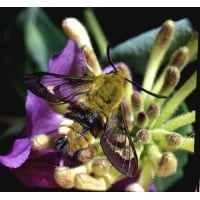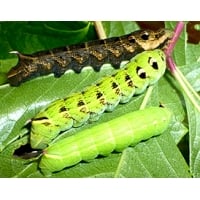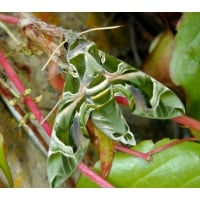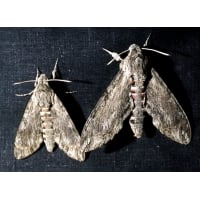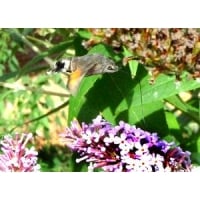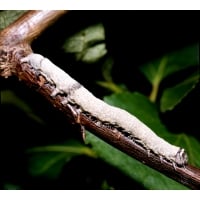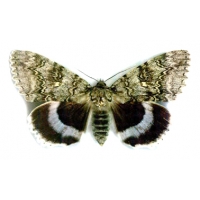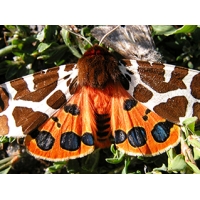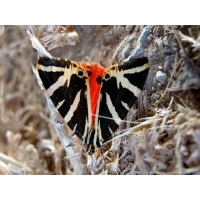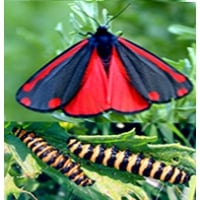SPRING and SUMMER EGGS and LARVAE Order now for supply in season
Pine Hawk Hyloicus pinastri
These are the last eggs for this season.
Extremely easy to rear on Pine. The larvae change colour and pattern as they shed their skins and grow, each new attire demonstrating remarkable camouflage. They do best sleeved on growing pine but can also be reared on cut food as long as well cared for and hygienic conditions maintained. The larvae pupate in the soil. Store pupae refrigerated until next summer.
Broad-bordered Bee Hawk Hemaris fuciformis Larvae
A very difficult species to obtain as eggs and larvae. Sent out in June, supplies will be limited. Larval foodplant is Honeysuckle. Not difficult to rear. Hibernation is in the pupal stage. The moth emerges with a thin layer of grey scales on the wings. Remarkably, on its first flight, the scales are shed, leaving transparent bee-like wings.
Elephant Hawk Dielephila elpenor
A most attractive and easy species to rear. The larvae feed on Willowherbs, Fuschia, Virginia Creeper, Vine and Bedstraw. Fast-growing, the larvae have two colour forms, starting green they change to black, or a lovely green form, the green being the rarest.
The larvae pupate amongst leaf litter on the ground, and emerge next spring as one of the most beautiful of all hawkmoths.
Small Elephant Hawk Dielephila porcellus
Very seldom can we offer eggs and larvae of this brilliantly coloured and delicate little Hawkmoth. The larvae are miniatures of the Elephant Hawk.
The best foodplant is Bedstraw Gallium, any species, also Willowherb, Purple Loosestrife, Impatiens (Balsam and perhaps Busy Lizzie), Vine and Parthenocissus. Don’t miss this opportunity of rearing the Small Elephant Hawk this year.
Oleander Hawk Daphnis nerii
Because the egg stage is only a few days, they cannot be supplied outside Britain.
One of the finest of all Hawkmoths. The larvae are very fast growing indeed and they consume a lot of food. It is often possible to have the larvae from hatching to pupation in little more than a month.
Larvae thrive on Privet and can be reared on Periwinkle Vinca, or Honeysuckle Lonicera. Suitable for winter or summer rearing. Oleander Nerium is a natural foodplant but it is often tough and leathery, so the alternives are usually better than Oleander.
Convolvulous Hawkmoth Herse convolvuli
The moths have started breeding. Larvae will follow next month. Not available every year: these are very special!
Huge caterpillars: fascinating to rear. The pupa has a curious proboscis, like a jug handle. Feeds at dusk, Tobacco plants, Petunia, Lillies and Phlox.
Larval Foodplants: Convolvulus, Field Bindweed, Hedge Bindweed, some Morning Glories.
Best reared in Plastic Rearing Containers: see the advice at the heading of that section of the WWB website. Keep at about 25 degrees C. The paper lining and food must be changed EVERY day. Food needs to be very fresh at all times. When larger the larvae may need this change twice a day, due to their productivity!
Larvae pupate in deep compost. Amazing pupae with jug-handle exterior proboscis case!. The pupae may be held cool until next season or incubated to produce moths in a month or two.
Hummingbird Hawk Macroglossum stellatarum
In summer this species migrates to Britain and provide much sought after breeding stock. There are some available NOW.
The larvae grow very fast, feeding on Bedstraw, Woodruff, Goosegrass and Madder.
Pupae are formed in litter on the ground and moths emerge this year.
Watching the moths feeding with amazing agility is a memorable experience!
Don’t miss this opportunity!
Clifden Nonpareil (Blue Underwing) Catocala fraxini
The largest underwing, spectacular blue. Overwintering eggs to hatch in spring.
This species is became almost extinct in Britain. Now there are some new colonies. Continental races have darker forewings, with less distinct markings. The largest of all Underwings and remarkable for its BLUE hindwings. The young larvae are immensely active and care must be taken when transferring them to fooplant on hatching, because they can tangle themselves up if you try to move more than one at a time! Feed on Aspen and other Poplars. The larvae are the largest of this genus and very satisfying to rear. Moths emerge in late summer, laying eggs that overwinter.
Clifden Nonpareil (Blue Underwing) Catocala fraxini
Breeding has been such an enormous success that we can offer eggs at a fraction of their normal price!
The largest underwing, spectacular blue. Overwintering eggs to hatch in spring.
This species is became almost extinct in Britain. Now there are some new colonies. Continental races have darker forewings, with less distinct markings. The largest of all Underwings and remarkable for its BLUE hindwings. The young larvae are immensely active and care must be taken when transferring them to fooplant on hatching, because they can tangle themselves up if you try to move more than one at a time! Feed on Aspen and other Poplars. The larvae are the largest of this genus and very satisfying to rear. Moths emerge in late summer, laying eggs that overwinter.
Garden Tiger Moth Arctia caja 50 larvae
The price for 50 Woolly Bears has been substantially reduced to encourage releasing in the wild.
Children love them!
Garden Tiger larvae Woolly Bears grow fast on Dock, Dandelion, Dead Nettle, Nettle and many other hedgerow plants, also Pussy Willow Salix caprea and Osier Willow Salix viminalis. You can also feed them conveniently on Cabbage.
Now a most difficult species to obtain.
These are spring and summer larvae. In the wild, late summer larvae would hibernate, but if you keep them warm and light, many will produce another generation this year.
If you wish to hibernate Wooly Bears, sleeve them in autumn on Willow or Sallow (Pussy Willow). The falling leaves curl to form a ventilated ball in which the larvae hibernate. If all goes well in winter the larvae emerge in spring and feed from the new spring leaves.
From October to spring the larvae are in hibernation. Orders are booked for dispatch when the larvae awake and feed.
Jersey Tiger Moth Euplagia quadripunctaria
A very active and exotic European tiger moth, which occurs in a very small area of the south-west of Britain, the Torbay area, as well as in Europe.
The larvae feed on Hemp Agrimony, Dandelion, Forgetmenot, Dock, Nettle, Dead Nettle, Plantain, Bramble and other low-growing plants. The larvae, as with other Tigers, have prominent tufts of hair, and colourful markings. The hairs may give a rash on handling, but seldom do. Pupae are formed in leaf litter.
Hibernating is achieved well on potted foodplant protected from predators by a fine net enclosing pot and plant. In spring the larvae begin to feed again and produce moths in summer.
Cinnabar Moth Hipocrita jacobaeae
Once an extremely common British Moth, less common over most of Europe, but over the last 10 years there has been a marked decline in numbers. The summer of 2016 brought a reversal of this decline and we can help this species back from danger of disappearing.
The larvae feed on Groundsel and Ragwort Senecio. The larvae are ringed in bright orange and black, nature's warning colours, and they absorb chemicals from the foodplant that adversely affect predators who ignore the warning. Ragwort is a mis-understood plant that provides an abundance of nectar to bees, butterflies and other insects. There is evidence that Ragwort plants that are pulled up and left to dry, can be detrimental to cattle and horses if they eat the dried plants. Animals can be seen grazing safely in fields containing growing green plants. There is nothing to be gained from pulling up Ragwort plants, because they are biennials that flower and die in the same year. So a patch of Ragwort can provide valuable nectar to thousands of wild insects, and be host to Cinnabar larvae and, job completed, it dies at the end of summer.
The Cinnabar moth flies by day, more than by night, and is protected from predators, by the very striking colours of charcoal and scarlet, and bitter-tasting chemicals derived from the larval foodplant, enabling the moth to display its bright colours, yet not be attacked by predators.
Cinnabar larvae can be raised in sleeves on growing Ragwort. We find the sleeves fitted with a zip are particularly successful. When the larvae are large, if you put in the sleeve several handfuls of springy wood shavings or dried leaf litter, they will form thin silken cocoons in which to pupate.
Could you help to spread this colourful day-flying moth again in your area?
Store pupae cool for the winter, even in a fridge, loose in a plastic box, without any padding. In May lay them out in an emerging cage and wait for the moths to emerge.


